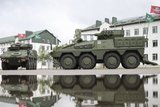BAE Systems to supply AAV7A1 to Brazil
BAE Systems will deliver 23 upgraded Assault Amphibious Vehicles (AAV7A1) to the Brazilian Marine Corps under an $82 million contract announced on 21 December.
The vehicles will be delivered in the Reliability, Availability, and Maintainability/Rebuild to Standard (RAM/RS) variant. This variant provides a more powerful engine and drive train, as well as an upgraded suspension system. The vehicle also provides improved mobility and repair capabilities while transporting troops and cargo from ships.
BAE Systems will provide the vehicles along with all tools and test equipment required to support vehicle maintenance; an initial sustainment capability, including spare parts and field service support, as well as training for the vehicle users, will also be provided.
Production will begin in June 2016 with vehicle deliveries running from February 2017 through to the end of the year.
Deepak Bazaz, director of new and amphibious vehicles, BAE Systems, said: ‘These new vehicles will have major capability enhancements, which will give the Brazilian military an amphibious vehicle with improved speed and reliability beyond the current configuration.
‘We have a strong track record of supporting the Brazilian military and will continue that close working relationship throughout this programme.’
Related Equipment in Defence Insight
More from Land Warfare
-
![Hungary set to begin using Hero 400 loitering munitions]()
Hungary set to begin using Hero 400 loitering munitions
Developed by Israel's Uvision and with systems being sold in the thousands to multiple European NATO countries and the US, the Hero family of loitering systems is also in production in the US and Italy, the latter through Rheinmetall.
-
![Croatia orders Leopards and CAESAR howitzers as Lithuania orders more CAESARs]()
Croatia orders Leopards and CAESAR howitzers as Lithuania orders more CAESARs
The Leopard is becoming the tank of choice in central and eastern Europe as Croatia joins Lithuania, the Czech Republic and Hungary in ordering the platform. Lithuania and Croatia have also signed for CAESAR howitzers.
-
![Light Reconnaissance Strike – enabling a vital mission set (Studio)]()
Light Reconnaissance Strike – enabling a vital mission set (Studio)
A new system-of-systems concept will unlock digital integration of sensors and weapons for Light Forces, allowing them to shape the battlefield environment on their own terms and upgrade legacy platforms.
























